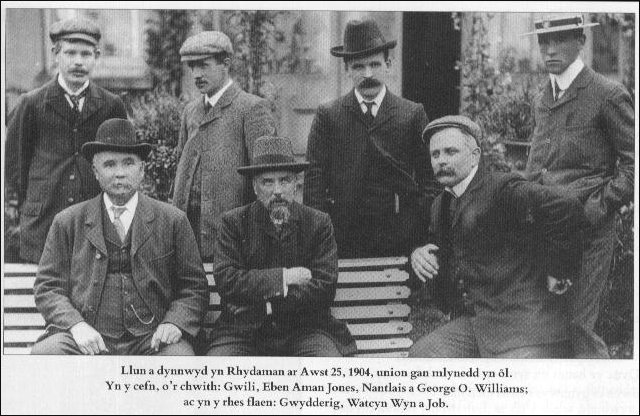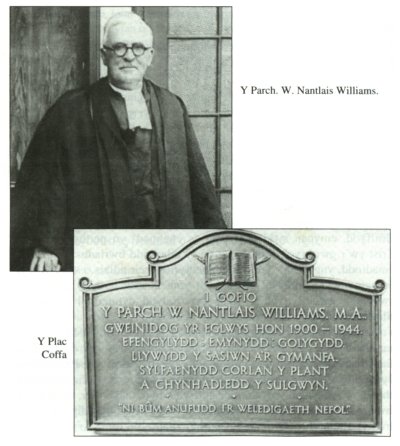The Reverend William Nantlais Williams was the best known and longest serving minister of Bethany Methodist Chapel in Ammanford. Born at Llawr-cwrt, Gwyddgrug, near Pencader, Carmarthenshire on 30th December 1874, during his long and productive life he was a chapel minister (Presbyterian), editor, poet and hymn writer. He became the minister of Bethany, a Calvinistic Methodist chapel, in 1900, not long after its founding in 1881 and stayed a minister there for 44 years. He retired as minister in 1944, living out his life in Ammanford until his death in 1959 at the age of 85. The youngest of ten children of Daniel and Mari Williams, he was educated at New Inn elementary school and at the age of 12 he was apprenticed with his brothers as a weaver. He was brought up in New Inn church, where he began preaching in 1894. He was educated for the ministry at Newcastle Emlyn grammar school and Trefeca College. He took an interest in poetry at a young age and published a collection of his poems, Murmuron y Nant (Murmurs of the Brook) in 1898, while he was a student. He won a bardic chair under the adjudication of Watcyn Wyn (Watkin Hezekiah Williams – see the entry in the 'People' section of this website) at an eisteddfod in Ammanford in 1899, and he received a call soon afterwards to be pastor of the recently established church of Bethany in our town. He was ordained in 1901, and he laboured in Bethany from 1900 until his retirement in 1944 (having supervised also the small church of the Presbyterian Church of Wales in Llandybie during the first years of the twentieth century).
Photo: A nest of singing bards. Nantlais (top row, third from left) at the time of the 1904 Revival. Local poet and educator Watcyn Wyn is in the centre of the bottom row (a biography of Watcyn Wyn can be found in the 'People' section of the website, or click HERE). Local poet John Jenkins (Gwili) is first left, top row. Gwili can be found in the item on Edward Thomas in the 'People' section or click HERE. Watcyn Wyn's son George O Williams, the first headmaster of Amman Valley Grammar School in 1914, is top row, far right. An item on Amman Valley Grammar School in the 'History' section also contains a memoir of George O Williams. The text below the photo reads: "Picture taken in Ammanford on August 25th 1904, a hundred years ago. In the back, from left: Gwili, Eben Aman Jones, Nantlais and George O. Williams; and in the front row: Gwydderig, Watcyn Wyn and Job." (Photo from Summer 2004 edition of 'Barddas'). His ambition at that time was to preach at preaching festivals and succeed as a poet in eisteddfod competitions. He was joint-winner at Bangor national eisteddfod (1902) for composing six lyrics; he won the bardic chair at the Meirion eisteddfod in 1903, and the chair at the eisteddfod held in the Queen's Hall, London, in 1904. That year the religious Revival spread to Ammanford, and Nantlais was heavily affected by the stirring events. He determined to consecrate his life thenceforth to evangelising and fostering the spiritual life of the churches. He married twice; first in 1902, Alice Maud Jones (grand-daughter of the eccentric Thomas Job, Cynwyl), and they had three sons and two daughters; she died in 1911. He remarried in 1916, to Annie Price (head-mistress of Mountain Ash school and daughter of T. Price, minister of Brechfa). He died on the 18th June 1959, and his remains were buried in front of the new chapel of Bethany.
After the Revival Nantlais became associated with the leading personalities who attended the annual evangelical conferences at Keswick and Llandrindod Wells, and in 1917 he established an annual conference of the same kind at Ammanford. His labours at Bethany proved very successful; a schoolroom was built at Pantyffynnon in 1904, and another in Tir-ydail in 1906. A church was established there in 1911 and a beautiful new chapel was built at Bethany in 1930. Nantlais was elevated to the chair of the South Wales Association (1943), and he was Moderator of the General Assembly (1940). He corresponded for years with Eluned Morgan of Patagonia and at her earnest request Nantlais went on a preaching tour for three weeks in the Welsh colony in Patagonia in 1938.
Although Nantlais refrained from competing at eisteddfodau after the Revival, he continued to write, consecrating his talents and his poetry thereafter to spreading the Gospel. He was one of the editors of 'Y Lladmerydd' (The Interpreter) from 1922–26, and editor of 'Yr Efengylydd' (The Evangelist) from 1916–33, and 'Trysorfa'r Plant '(A Children's Treasury) from 1934–47. He composed many hymns for children: indeed there was scarcely anyone more successful than he as a hymn writer for children. These hymns were published in three collections, 'Moliant Plentyn' (A Child's Praise) , part 1 (1920) and part 2 (1927), and 'Clychau'r Gorlan' (Bells of High Tide) in 1942. Many of his fine, inspired hymns are to be found in the present-day hymnals of all denominations. There is a collection of his best hymns in 'Emynau'r daith' (Hymns of Voyage) in 1949, and in 'Clychau Seion' (Bells of Sion) which he edited c. 1952. He also published a number of children's songs, as well as other musical works. Even though he refrained from competing, he did not lose his gift as a lyrical poet, as was shown in his anthology of poems, 'Murmuron Newydd' (New Murmurings) in 1926, and his children's rhymes, Darlun a chân (Picture and Song) in 1941. Before the end of his life, in recognition of his literary contribution, he was awarded an honorary M. A. degree by the University of Wales. He contributed extensively to the periodicals which he edited, and to 'Y Goleuad' (The Light). There are chapters of reminiscences in the latter (1955), which were published in 1967 under the title 'O Gopa Bryn Nebo' (From the Top of Nebo Hill).
He was known as a stern leader, keeping a disciplined watch over his flock. Like his fellow preacher-poets at Ammanford, Llwyd and Watcyn Wyn, he was a highly accomplished poet and hymn writer, publishing several volumes of verse and hymns, and many other works of a devotional nature. He also published a memoir of a local businessman and evangelical Christian, one William Herbert (1859–1937), entitled "William Herbert of Ammanford – Saint, Businessman, Preacher".
As can be seen above, he wrote extensively for children and those of a certain age will no doubt remember singing one of his hymns at Sunday school in their now distant childhood, "Iesu, cofia'r plant", (Jesus, remember the children). Given the 'ethnocentrism' of its words however, it's hardly surprising this hymn is no longer sung today. With the multi-cultural mix of modern Wales, even in Welsh speaking rural areas, this hymn, a relic from an earlier, less sensitive era, has been quietly dropped: embarrassment is the very least offence it would cause if sung by children now. These days the hymn surfaces only when nostalgia raids the dustbin of memory, where such attitudes have, hopefully at least, been quietly consigned.
Here, with an English translation, is the hymn's first verse and chorus:
Draw, draw yn China a thiroedd Japan,
.....Plant bach melynion sy'n byw,
Dim ond eilunod o'u cylch ym phob man!
.....Neb i ddweud am Dduw!
..........Iesu, cofia'r plant,
..........Iesu, cofia'r plant,
.....Anfon genhadon ymhell dros y môr,
..........Iesu, cofia'r plant,
..........Iesu, cofia'r plant.Over there in China and the lands of Japan
.....Little yellow children live,
Everywhere around them only idols!
.....No-one speaks of God!
..........Jesus, remember the children,
..........Jesus, remember the children,
.....Send missionaries to them far across the ocean,
..........Jesus, remember the children.In this somewhat dismissive attitude towards other peoples of the world, Nantlais was not alone, nor was he without precedent, as this verse from a hymn by the Calvinist Methodist hymn writer John Elias (1774–1841) all too unfortunately demonstrates:
Dioddefod angau loes
Yn ufudd ar y bryn;
.....A'i waed a ylch yr Ethiop du
Yn lân fel eira gwyn.He suffers the pain of death
Obediently on the hill;
.....And His blood washes the black Ethiopean
Clean as white snow.[From the hymn 'Ai am fy meiau i?' (Is it because of my sins?). Translation made for this website].
Unlike Nantlais's 'Iesu, cofia'r plant', this hymn is still sung today, but a new inter-denominational hymn book published in 2001 'Caneuon Ffydd' (Songs of Faith) has quietly censored the offending line (there are no prizes for guessing which it is) so that the hymn now reads:
Dioddefod angau loes
Yn ufudd are y bryn;
.....A'i waed a ylch y galon du
Yn lân fel eira gwyn.He suffers the pain of death
Obediently on the hill;
.....And His blood washes the black heart
Clean as white snow.Other well known hymns from the pen of Nantlais were, 'Plant bach Iesu Crist ydym ni bob un' (Little children of Christ are we, every one) and 'Uno wnawn a'r nefol gor' (We will join the heavenly choir).
When Amman Valley Grammar School became a comprehensive in 1970, one of the school houses was called 'Nantlais' in his memory.
The other houses in the new comprehensive school were also named after local poets, namely Watcyn, Amanwy and Llwyd. The houses in the former Grammar School had been named after the Welsh princes – and warriors – Hywel, Glyndwr, Llewelyn and Dewi. An improvement in whom we should regard as role models, perhaps.
Nantlais and his memorial plaque on Bethany wall.SOURCES:
Dictionary of Welsh Biography 1941–1970, page 311, published by the Honourable Society of Cymmrodorion, 2001
Ammanford, Origin of Street Names and Notable Historical Records, W T H Locksmith, published by Carmarthenshire County Council in 1999Date this page last updated: October 1, 2010


